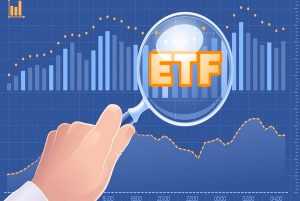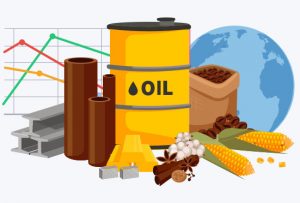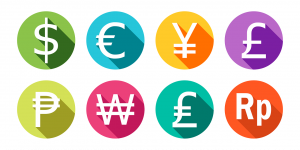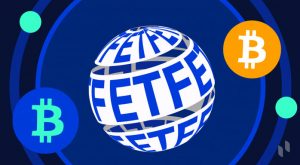Disclosure: Privacy Australia is community-supported. We may earn a commission when you buy a VPN through one of our links. Learn more.
Cryptocurrency ETFs Explained (Beginners Guide for 2024)
The world of finance is complex. Everyone knows this, but few actually venture into that world looking to find out just how deep the rabbit hole goes.
But with cryptocurrency getting more and more valuable every day, more and more people are starting to wonder: What is going on in Wonderland?
Here, we will be presenting a guide on the basics of three things:
- Cryptocurrencies and what they are, as well as how they work
- ETFs and how they are traded in the marketplace
- How cryptocurrencies and ETFs combine
Cryptocurrency, as you probably know, is a currency that has no real-world counterpart. If you go to your bank, you can withdraw money from your bank account, and they will give you pieces of paper that represent the money that left your account. This is not how cryptocurrency works.
Table of Contents:
- What is Cryptocurrency
- What are ETFs
- What Other Securities are There
- How is Cryptocurrency Traded
- Why do People Buy Cryptocurrency ETFs
What is Cryptocurrency?

The answer to that question changes from currency to currency, but it is all based on the principle set forth by Bitcoin and Ethereum (there are debates as to which one codified it first and better).
Imagine you are buying toilet paper with normal money. Paper money is incredibly secure because it is right there in front of you. You hand it to the store clerk and now there is nothing and no one to say that you own that money more than they do.
When you pay with a credit or debit card, about the same thing happens. You put money from your paycheck into the bank. When you swipe your card for the toilet paper, the bank tells the clerk that you have the money to pay for it, and it is transferred over to the store you are buying from.
But what if instead of handing them the money right there, you told the clerk, “I am going to take this toilet paper and pay you next week.” Well, the clerk would not like that very much.
There is no guarantee that you actually come back and pay the money you said you would. With paper, the money is right there in front of both of you. With a credit card, it is a conversation between banks.
Cryptocurrency endeavors to solve that problem.
Cryptocurrency is a currency that takes its value from the fact that even though it does not physically exist, we can confirm that it exists. It does this with a special technology that helps us do just that.
How Does Cryptocurrency Work?

The technology that makes cryptocurrency work is called “blockchain technology”. The idea behind it is that there are multiple computers on different networks all connected by the same blockchain app.
This app tracks the presence of cryptocurrency within the entire blockchain. That means that the entire blockchain has records of what happens on the whole rest of the blockchain.
If you swipe a cryptocurrency card to pay for toilet paper, rather than a single bank saying that your money is there, the entire blockchain will verify that it is there.
This is where cryptocurrency gets its value. In fact, it is where paper money and money in banks get their value: Paper money is there because you can see it. Money in banks is there because a trusted bank says it is there. And cryptocurrency is there because everyone in the blockchain says it is there.
Now that you know some basics as to how cryptocurrency works, let’s talk about ETFs.
What are ETFs?

ETF stands for “exchange traded fund”. But when you hear those words sounded out, you really do not get a clearer picture of what is going on in an ETF.
Is it a way of buying things? Is it a type of account? Is it a currency or way of storing currency? The possibilities seem endless if you are new to the trade.
Let’s start with a partial definition: “ETFs are bundles of securities.”
This is a good definition to start with because it only relies on one other term: Securities. If you can understand what a security is, you can understand what an ETF is and what it does.
What is a Security?
To begin with, “security” in this situation is not a “sense of security” that you might feel while in an armored car. Rather, it is a noun for an object that can be traded on the marketplace.
A security is anything that can be claimed to exist and traded on the market. Paper money is a security. The money in your bank account is a security. But the security most people are familiar with is stocks.
This is because stocks are the security that most people think of as a tradable security. Stocks are shares in companies. By owning a share in a company, you own part of the profits that the company makes.
So, let’s examine that definition of ETFs again: “ETFs are bundles of securities.” That means we can restate this definition as “ETFs are bundles of stocks.” And, as it happens, that is true!
Exchange traded funds can be bundles of stocks, usually from different companies. When you trade an ETF of stocks you are usually getting a bundle of stocks from a certain industry. That means that you can get an ETF that contains stocks from the automotive industry, the aerospace industry, and so on.
But why? Why get an ETF of stocks in the first place? What does a bundle of any security do for you?
What do ETFs Do?
When you get a bundle of stocks you will probably not be getting a bundle of whole stocks unless the industry is new or full of lower-end competitors. For example, an ETF of eCommerce stocks is bound to include Amazon stocks. But that will either make the ETF obscenely expensive or give you a partial stock.
But you can make money even with these partial stocks. That is one thing that should be stated right out of the gate: ETFs can make you money. The way they do that is dependent on the security you have.
Stocks, for example, usually make money through dividends. Dividends are the money you make when a stock increases in value, and you sell the increased value of the stock. This does not make money quickly, so you should only do this when you know the stock has long term value.
ETFs can help you make money, but they can also help you understand money. Not only do they bundle shares together, but they tend to (but do not always) try to get shares together of an entire industry.
This is not possible in some massive industries. In those cases, the bundle will involve an “index”. Remember that word for later. When they can get an entire industry, however, they do.
An ETF of an entire industry means that even if you only have partial ownership of all the stocks in that industry, you will be able to understand it better. Those partial stocks will still shift in value in accordance with the total stocks they are part of. You will watch the industry’s stocks in real time.
This is a much more reliable way of getting updates on an industry than watching a stock ticker on a news channel or finance site. Remember, those are reporting on what you are seeing in front of you.
What is an Index? 📊️
Earlier we mentioned the term “index” and told you to remember it. We did this because indexes are an important part of ETFs that have so far gone unmentioned in our description of them.
And that is because indexes are usually where the definition of ETFs lose people.
While the “ETFs are bundles of securities” and “ETFs are bundles of stocks” are true definitions, they do not paint the whole picture. The most complete definition of an ETF would be, “ETFs are securities bundled by an index.” Clearly indexes are important since they are the things doing the bundling.
An index is not a type of security. Instead, it is a tool for organizing securities. You can think of them like address books. But instead of listing addresses, they list all the different stocks according to a criteria.
That criterion is, as stated before, most commonly the industry that they are part of. But sometimes (very rarely, but significantly) an index will be organized by a different means. The most well known of these is the S&P 500, which is an index tracking the 500 companies with the highest “market cap”.
Many companies, banks, and hedge funds will have indexes that they use internally to organize their securities. A common practice for national banks is to index the securities they hold by region.
Since the banks are using their customers’ money to trade, they need to keep track of what money they are using on what securities. Their solution is to index the securities by what region they pulled the money from. For example, stocks they bought with money from the west coast will be in one index.
But something you have probably noticed is that “securities” is not interchangeable with “stocks”. Why is that? Well, to add another layer to ETFs, they do not always have to be made of stocks.
What Other Securities are There? ➡️
The other kinds of securities are as follows:
- Commodities
- Foreign currency
- CFDs, options, and futures (AKA, different types of stone)
- Bonds
We will go over each briefly.
Commodities

ETFs can bundle together all types of securities, and sometimes multiple types of securities (though this is rare). A good example of this is how ETFs interact with commodities.
Commodities are by far the easiest security to understand. This is because commodities actually exist in some capacity. Stocks and other securities just exist on paper. They have no physical component.
But commodities are more than words on paper. Gold, wheat, granite, even paper amusingly, all of these are commodities. This is because commodities are bulk orders of things people actually use.
Commodities are traded by those who “procure” them. For fruits and vegetables, that means those who grow them. For minerals that means those who mined them. You can also trade them if you buy them. In short, you have to be the one that acquired them in order to sell them. Everyone else must buy.
Foreign Currency

Another form of security is the currency every country uses. Remember how we said the money in your bank account is a security? This is true both in using it to shorten trade as well as being traded itself.
Foreign currency trade means buying a currency at one value in one market and then selling it in another value in another market. The AUD, for instance, is worth more in Indonesia where it is seen as exotic and powerful compared to Australia where it is seen as mundane.
Therefore, you can sell your AUD for more Indonesian Rupiahs than it is actually worth in Indonesia. Once you have done that, you sell you Indonesian Rupiah somewhere where they are worth more AUD than you paid to get them. Just by moving money around you have increased the money you have.
CFDs, Options, and Futures

All of these are included in the same category because they are all different ways of buying stocks without actually buying stocks. If that sounds counterintuitive to you, then you are not the only one.
Something that stock market connoisseurs discovered in the late 1970s and early 1980s is that you do not have to sell a stock in order to have something to trade.
CFDs, for instance, mean making a contract to buy/sell a stock at a precise time at a precise price, usually in the future and for a lower price.
CFD stands for “contract for differences”, and in this case you are not necessarily buying/selling the stock. You are buying/selling a contract that says you will buy/sell the stock.
Similarly, options are contracts that represent the option to buy a stock or not buy it. When you buy a stock’s option, you are paying to make sure that no one else can buy it, while not actually taking ownership of it yourself. After a certain amount of time, you can choose whether to buy or not.
Futures are similar to CFDs in that they are contracts to buy certain stocks at certain future dates. However, futures do not always set a price. They are also more flexible, at times including more than one share of a stock or less than one but more than zero shares of a stock.
There are many different kinds of securities related to stocks, but they all add up to the same thing: When you buy the stock, what you pay for it, and how much of the stock you end up getting.
Bonds

The last type of security you need to be concerned with is bonds. Luckily, bonds are relatively simple as far as securities go. Bonds generally represent a debt that a company or person has incurred.
In the case of companies, the debt is usually incurred as part of a business plan. Companies issue bonds with the intention of using the money for a short term operation, repaying the bonds once those operations turn a profit. Think of them as short term investments into larger companies.
Bonds can also be traded with debt owned by individuals. The debt holder of a person’s medical debt, student loans, business loans, mortgage, etc. can issue bonds of those debts. These bonds allow other bodies to buy the debt, either in part or in full. This will usually result in a benefit to the person in debt.
Most of the time, the companies and debt holders that issue bonds do so to provide investors with a short term income option. This is because their stocks grow at a slow and consistent rate.
You will never make your money back fast investing in a stock that grows slowly (though you will make it back over time). But with bonds you can expect your money to grow within a fiscal year.
How is Cryptocurrency Traded?
At last, we come to the main question of this article: How do cryptocurrencies work with ETFs?
Let’s go back to our definition of ETFs: “ETFs are securities bundled by an index.”
There can be indexes of stocks, currencies commodities, CFDs, options, bonds, and also cryptocurrencies. Crypto is a curious security because it can be navigated in a few different ways.
As you might expect, cryptocurrency is usually bought and sold like a foreign currency. Investors will buy one currency, sell it for another currency, and then buy a country’s currency with the second currency. The end result nets them a profit. But that is not the only way to trade in cryptocurrency.
There are other investors that like to trade crypto like it is a stock. That means doing one of two things: Either trading the currency for a short term income or trading it for long term growth.
Short term income strategies for cryptocurrencies involve buying cryptocurrency that is booming. That means buying a currency that is on the rise but has not reached its peak yet. This is the classic stock market technique of buying low and selling high. This means income is gained from volatile currencies.
Long term growth strategies focus on the “dividends” mentioned earlier. In the case of cryptocurrency, dividends work similarly. You sell periodically in the amount the currency increased in value relative to the price you bought the currency at. That means you never sell everything all at once though.
These strategies are very different from making money just by moving the cryptocurrency around. They also demand very different cryptocurrencies. You can trade cryptocurrency like it is foreign currency if it is booming and busting, but that same currency cannot be used for a growth strategy.
How do Cryptocurrency ETFs Work?
As you can probably imagine given all the other definitions, we have laid out already, cryptocurrency ETFs are multiple cryptocurrencies bundled together by an index that organizes them in a certain way.
But while stocks, foreign currencies, commodities, and bonds can be easily associated with specific industries, cryptocurrencies are not as easily organized. There are cryptocurrencies flowing through every industry. And unlike foreign currency, cryptocurrency is not tied down to a geographic region.
In the case of foreign currency, you can at least organize it to the country that a given currency comes from, and therefore the industries that serve as that country’s primary exports. You can even index many different currencies to one industry if you want to work the problem from the other direction.
Similar indexing can be done with cryptocurrency, but many currencies can move around so much that these indexes rapidly become out of date. This has to do with how cryptocurrency is spent in the world.
How is Cryptocurrency Spent?
This is more important for understanding cryptocurrencies than you might think, as you cannot spend cryptocurrency the same way you spend regular currency. Remember how we mentioned that cryptocurrency has to check with the blockchain it is verified by in order to ever be spent?
Well, that process takes a while. Bitcoin, for example, has a massive blockchain that makes it take more than twenty minutes for the entire blockchain to approve a purchase. You cannot reasonably expect to hold up a line at a gas station because your crypto card is spending twenty minutes verifying.
For that reason, most cryptocurrencies are not used in normal consumer transactions. Nor are they used in transactions that require rapid transfers of funds. But this is only one form of verification.
That model is called “proof of work”, and it is the model Bitcoin, Ethereum, and many other, smaller cryptocurrencies use. But in the last few years a new model has risen in popularity: “Proof of stake.”
Proof of work uses the blockchain to prove that the currency is where it says it is at the time of the transaction. Proof of stake, on the other hand, shortens the time it takes for smaller transactions to occur by having the step occur in the background while the transaction is allowed to continue.
This is because in the case of proof of stake, while the exact ownership of the currency being spent is still determined by the blockchain, there is a method of allowing people to spend money.
When you swipe your card in a proof of stake system, someone else in the blockchain is allowed to cover the cost of your transaction with their pre-verified money. Doing so allows your transaction to occur instantly. Of course, you have to pay that person back later with interest.
This means that a proof of stake transaction requires a transaction fee, but the currencies involved are able to be used immediately. That also means that different currencies will usually be used.
Proof of work and proof of stake are hardly the only way that cryptocurrencies can verify themselves, but they are the easiest to understand. It is these verification processes that give crypto value.
How Does This Influence ETFs?
What all of this means for ETFs is that it gives ETFs a means of indexing all cryptocurrency. You can always index cryptocurrency according to the method it uses to verify its value.
These differing methods of verifying value translate into different ways of growing and shrinking value.
For instance, proof of work is highly reliant on processing technology. You may have heard of “cryptocurrency mining”. Crypto mining is done by using computers that do nothing all day but use their processing power to verify different parts of the blockchain. In doing so, they generate value in it.
This means that proof of work currency has a very steady way of gaining value. The value of Bitcoin might rise and fall due to market forces, but it will always have an upward force of each individual Bitcoin being verified by Bitcoin miners around the world. This makes it a good growth currency.
The money you make from proof of stake currencies is quite different. While they still have crypto mining to supply them with value, most of the money people make off of proof of stake is by providing stake. Someone will take part in a transaction, and you will speed it up by offering stake.
Doing this gets you money in return. With some currencies this will be more of the currency itself, in other cases it will be a real world currency (usually converted at a reduced rate).
What are Cryptocurrency ETFs Tracking?
Buying an ETF of proof of work currencies will tell you a lot about what is going on in certain industries, while also supplying you with information on how crypto mining is developing. Crypto mining is naturally tied to the strength and availability of computing technology.
That means that if there is a shortage of super conducters, graphics cards, or other computer hardware that are integral to crypto mining, the value of proof of work currencies will suffer.
Compare that to proof of stake currencies, which are not as reliant on that technology.
Applying the same analysis with an ETF of proof of stake will tell you more about what the investment industry around those currencies is doing. This is because while proof of work currencies rely on a stable increase in value from mining technologies, proof of stake currencies rely on a constant flow of money.
Proof of stake currencies also rely on the amount people putting forward stake always being greater than or equal to the number of people relying on the system to do their transactions.
There has never been a point where the people who are spending has outnumbered the people offering stake. Since it benefits the stake holder to offer stake, it is unlikely that such a thing might happen.
Why do People Buy Cryptocurrency ETFs? 🛒️

As you might have surmised by now, the two main uses for ETFs are for tracking the growth of the securities within it or making money.
You can sometimes do both, but while selling off parts of an ETF will not usually compromise its value, it will make using it to track value much, much harder.
This can seem like a steep disadvantage, but there is a reason why people invest in cryptocurrency ETFs. Part of the appeal of cryptocurrency is that each currency is a decentralized currency.
The American dollar has its value set by the American Federal Reserve, and most currencies in the world base the value of their own currency off of the value of the American dollar. This is a highly centralized method of organizing the value of a great many currencies, as it all goes back to one country.
Problems develop with that situation when forces within that one country end up negatively effecting the value of that currency. If a bank that is “too big to fail” starts defaulting on its debts or issuing mass margin calls, that can bring down the USD, which in turn brings down AUD, Yen, and other currencies.
If a bank that is heavily invested in the paperclips industry is discovered to be perpetrating mass fraud, then the paperclip industry will suffer. The same applies to the whole American economy, basically.
Cryptocurrency does not have to worry about that kind of centralization. If a bank starts trying to fudge the numbers on their Bitcoin holdings to artificially increase the value of their paperclip industry shares, then the rest of the blockchain will quickly sort out exactly how valuable that bank’s holdings are.
This means that a cryptocurrency ETF will be far more stable than an ETF of most other securities, at least in theory. Cryptocurrency is just not subject to the arbitrary market forces of normal currency.
Conclusion 💡️
There is a lot you have to know in order to really “get” what cryptocurrency ETFs are. But once you get past the initial hurdles of indexes and how currencies “prove” their value, it is quite simple.
Just remember that none of this is a get rich quick scheme. ETFs are rarely bought for income purposes. The knowledge they bring is unlikely to come with a windfall of cash. Be patient, and they will grow. And once they start growing, it will only be a matter of time before you make your money back.
You Might Also Like:






